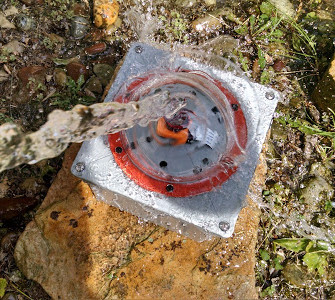Skywatching is a fascinating hobby, but does have the rather large drawback of needing to be outside staring at the sky for extended periods of time. Then there’s the weather to contend with, even if you’ve got yourself a nice blanket and it isn’t miserably cold, there might be nothing to see if cloud cover or light pollution is blocking your view.

To address these issues, [Jason Bowling] decided to put a Raspberry Pi in a weatherproof enclosure and use it as a low-cost sky monitoring device. His setup uses the No-IR camera coupled with a cheap wide-angle lens designed for use with smartphone camera. The whole setup is protected from the elements by a clear acrylic dome intended for a security camera, and a generous helping of gasket material. Some experiments convinced [Jason] to add a light pollution filter to the mix, which helped improve image contrast in his less than ideal viewing area.
The software side is fairly straightforward: 10 second exposures are taken all night long, which can then be stitched together with ffmpeg into a timelapse video. [Jason] was concerned that the constant writing of images to the Pi’s SD card would cause a premature failure, so he set it up to write to a server in the house over SSHFS. Adding a USB flash drive would have accomplished the same thing, but as he wanted to do the image processing on a more powerful machine anyway this saved the trouble of having to retrieve the storage device every morning.
This isn’t the first time [Jason] has used a Pi to peer up into the heavens, and while his previous attempts might not be up to par with commercial offerings, they definitely are very impressive considering the cost of the hardware.















I reacall an ultra simple cloud watcher. 2 simple solar celks if the… v early 60s… 2 small candy acrylic domes, each painted with black checkerboard pattern, but oppisite… where one was black, the other was clear. A comparitor or such told of relative cloudiness. Probably Popular Electronics. I was 8, trying to read my ARRL… not knowing it was for adults… my parents wisely not deterring me. I garden. This is cool…
BillSF9c
Relevant XKCD: https://xkcd.com/1910/
I was more thinking of this https://xkcd.com/941/
Oh now that’s cool!
Has anyone done this and submitted it here?
Obviously, the “weather people” are worse :)
Experimental day version for intra-minute cloud passing forecasting
http://www.mdpi.com/1424-8220/17/5/1116
So the stars do actually twinkle?
the earth atmosphere causes the twinkle.
I think [Jason]’s follow up post (from last week) is a great expansion on just pointing a camera skyward as it helps speed-up observations by identifying frames that may have something interesting in (better than having to review every single shot).
http://shortcircuitsandinfiniteloops.blogspot.co.uk/2017/11/automated-meteoraircraftsatellite.html
Hey, thanks guys, much appreciated. It was a fun project, I hope others find it useful.
Spot the Geostationary Satellite!
Was wondering what that was – now I feel dumb. About 7:30 or 8:00 right on the tree line? That stood out immediately. Cool.
“setup is protected from the elements by a clear acrylic dome intended for a security camera”. Except for one, the sun. That little greenhouse will get awfully hot. Raspberry Pi’s are not automotive or military temperature rated (as well as their cheap plastic enclosures).
Agreed – in fact, I couldn’t even find a published temperature range for the Pi, I don’t think they did temp range qualification testing. I’m guessing it would probably be the industrial temp range, so a hot summer day in the sun would exceed it. If I find the project sufficiently interesting long term, I’ll need to find a board/cam that is more rugged. It’s not currently deployed full time outside – I take it out on nights that are forecast to be clear.
That dome probably will cloud if exposed to the sun long term, too. I’m not sure how you fix that, beyond periodic replacement.
Use some form of “safing” mechanism such as space telescopes use to prevent their optics from getting burned out by pointing at the Sun. A moveable door/hatch, maybe you could use a larger half dome to rotate over the weather dome during the daytime.
Neat idea. Thanks.
If any of the clear dome is outside the camera’s field of view you might tape off the part the lens looks through and paint the rest of the inside surface with either white or metallic silver, and then black over that. The light/silver part would reflect solar energy away, the dark inside would prevent the camera from getting flooded with reflected light from inside the dome.
Just spitballing here.
You might want to look into a UV-resistant clear spray, the kind of stuff they put on car headlights to keep them from clouding up.
I didn’t know that existed. Thanks!
Meh… My screensaver in the ’90’s made the same type of videos. :P
Don’t forget to add a bag of drying agent (silica gel) because otherwise you will encounter condensation problems, especially if you leave it outside for a longer period of time and temperature drops.
So no problems with the sun burning the ccd?
Not sure yet. I haven’t deployed it outside except on clear nights. I plan to do that in the next few weeks though. I will be curious to see how it holds up.
When I saw the dome with the camera under it, I thought we were seeing a DIY FRIPON station:
http://www.skyandtelescope.com/astronomy-news/a-new-all-sky-meteor-network-in-france/
Reminded me of that too, but wasn’t that also once covered by HaD?
Found it: https://hackaday.com/2016/12/04/fripon-is-french-for-meteorite-hunting/
This great for UFO’s and meteors, also as a bird toilet. some professional versions invert everything. Dome mirror with a down facing camera above it with 3 thin supports. Dome gives 180 degree view. There is a cloud sourced meteor tracking net that aims to provide the source of each encounter, picked up by these camerae.
Looks like you may have found a geostationary satellite.